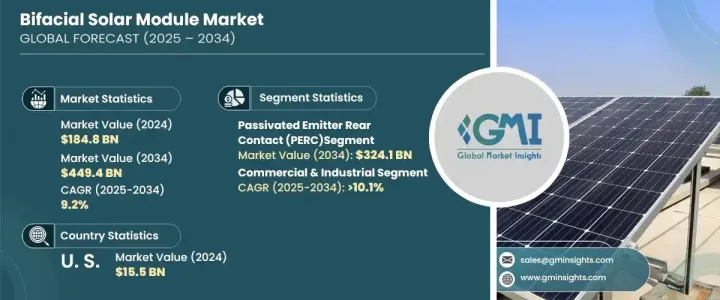PUBLISHER: Global Market Insights Inc. | PRODUCT CODE: 1716566

PUBLISHER: Global Market Insights Inc. | PRODUCT CODE: 1716566
Bifacial Solar Module Market Opportunity, Growth Drivers, Industry Trend Analysis, and Forecast 2025 - 2034
The Global Bifacial Solar Module Market was valued at USD 184.8 billion in 2024 and is projected to expand at a CAGR of 9.2% between 2025 and 2034. The market's rapid growth is fueled by the rising demand for high-efficiency solar solutions in large-scale energy projects and efforts to optimize the active area of solar panels for improved power generation. As the shift toward renewable energy gains momentum, industries worldwide are focusing on advanced photovoltaic technologies that maximize energy output while reducing costs. The ability of bifacial solar modules to capture sunlight from both sides increases their efficiency compared to conventional panels, making them a preferred choice for utility, commercial, and industrial applications.

Manufacturers are integrating cutting-edge technologies, including n-type Passivated Emitter Rear Contact (PERC), Tunnel Oxide Passivated Contact (TOPCon), and Heterojunction cells, to enhance efficiency and boost adoption rates. These innovations are crucial in driving product penetration across multiple sectors, especially as companies strive to meet sustainability goals. The growing awareness of bifacial modules' advantages-such as improved energy generation under diffused sunlight and their adaptability to various installation conditions-is expected to further accelerate market expansion. Additionally, government incentives, favorable policies, and decreasing costs of solar components are playing a pivotal role in encouraging adoption across key global markets. Emerging economies are also witnessing increased investments in solar infrastructure, further supporting the widespread implementation of bifacial solar technology.
| Market Scope | |
|---|---|
| Start Year | 2024 |
| Forecast Year | 2025-2034 |
| Start Value | $184.8 Billion |
| Forecast Value | $449.4 Billion |
| CAGR | 9.2% |
The PERC technology is anticipated to significantly contribute to the market's growth, with a projected valuation of USD 324.1 billion by 2034. This technology enhances energy conversion efficiency by improving light absorption and minimizing electron recombination, making it a game-changer in the industry. As demand surges for solar solutions that can perform efficiently in varied lighting conditions, bifacial modules are becoming an ideal solution. Their ability to capture reflected and scattered light makes them particularly beneficial for regions with high albedo surfaces, such as snowy landscapes and desert environments. With technological advancements making PERC-based modules more accessible in emerging markets, their market penetration is poised to rise.
The commercial and industrial sectors are expected to witness a CAGR of 10.1% by 2034, driven by the need for energy-efficient solutions that deliver higher yields while minimizing operational expenses. Space constraints in commercial and industrial installations make efficiency a top priority, leading to the increased adoption of bifacial modules. Their versatility in installation-whether on rooftops, building facades, or carports-adds to their appeal, making them a viable option for businesses looking to optimize solar energy production in limited spaces.
The U.S. Bifacial Solar Module Market, valued at USD 15.5 billion in 2024, is gaining traction due to strong federal incentives and government-backed policies aimed at lowering the upfront costs of solar installations. The demand for improved energy yields in large-scale utility projects is accelerating the adoption of bifacial technology, particularly in states with ambitious renewable energy mandates. With utilities striving to meet clean energy targets, the deployment of bifacial solar modules is expected to grow significantly in the coming years.
Table of Contents
Chapter 1 Methodology & Scope
- 1.1 Market definitions
- 1.2 Base estimates & calculations
- 1.3 Forecast calculation
- 1.4 Primary research & validation
- 1.4.1 Primary sources
- 1.4.2 Data mining sources
- 1.5 Market definitions
Chapter 2 Executive Summary
- 2.1 Industry synopsis, 2021 – 2034
Chapter 3 Industry Insights
- 3.1 Industry ecosystem
- 3.2 Regulatory landscape
- 3.3 Industry impact forces
- 3.3.1 Growth drivers
- 3.3.2 Industry pitfalls & challenges
- 3.4 Growth potential analysis
- 3.5 Porter's analysis
- 3.5.1 Bargaining power of suppliers
- 3.5.2 Bargaining power of buyers
- 3.5.3 Threat of new entrants
- 3.5.4 Threat of substitutes
- 3.6 PESTEL analysis
Chapter 4 Competitive landscape, 2024
- 4.1 Introduction
- 4.2 Strategic dashboard
- 4.3 Innovation & sustainability landscape
Chapter 5 Market Size and Forecast, By Thickness, 2021 - 2034 (USD Billion)
- 5.1 Key trends
- 5.2 < 2 mm
- 5.3 2 mm to 3 mm
- 5.4 > 3 mm
Chapter 6 Market Size and Forecast, By Type, 2021 - 2034 (USD Billion)
- 6.1 Key trends
- 6.2 Dual-Glass bifacial solar
- 6.3 Glass-Backsheet bifacial solar
Chapter 7 Market Size and Forecast, By Application, 2021 - 2034 (USD Billion)
- 7.1 Key trends
- 7.2 Residential
- 7.3 Commercial & industrial
- 7.4 Utility
Chapter 8 Market Size and Forecast, By Technology, 2021 - 2034 (USD Billion)
- 8.1 Key trends
- 8.2 Passivated emitter rear contact (PERC)
- 8.3 TOPCon
- 8.4 Heterojunction (HJT)
Chapter 9 Market Size and Forecast, By Frame Type, 2021 - 2034 (USD Billion)
- 9.1 Key trends
- 9.2 Framed
- 9.3 Frameless
Chapter 10 Market Size and Forecast, By Region, 2021 - 2034 (USD Billion)
- 10.1 Key trends
- 10.2 North America
- 10.2.1 U.S.
- 10.2.2 Canada
- 10.3 Europe
- 10.3.1 Germany
- 10.3.2 Spain
- 10.3.3 Netherlands
- 10.3.4 Poland
- 10.4 Asia Pacific
- 10.4.1 China
- 10.4.2 Australia
- 10.4.3 India
- 10.4.4 Japan
- 10.5 Middle East & Africa
- 10.5.1 UAE
- 10.5.2 Turkey
- 10.5.3 Egypt
- 10.6 Latin America
- 10.6.1 Brazil
- 10.6.2 Chile
Chapter 11 Company Profiles
- 11.1 3Sun
- 11.2 Boviet Solar
- 11.3 Canadian Solar
- 11.4 First Solar
- 11.5 Hanwha Q CELLS
- 11.6 JA Solar Technology
- 11.7 Jinko Solar
- 11.8 LONGi Green Energy Technology
- 11.9 Reliance New Energy
- 11.10 Sharp Corporation
- 11.11 Sunergy
- 11.12 Trina Solar
- 11.13 Vikram Solar




